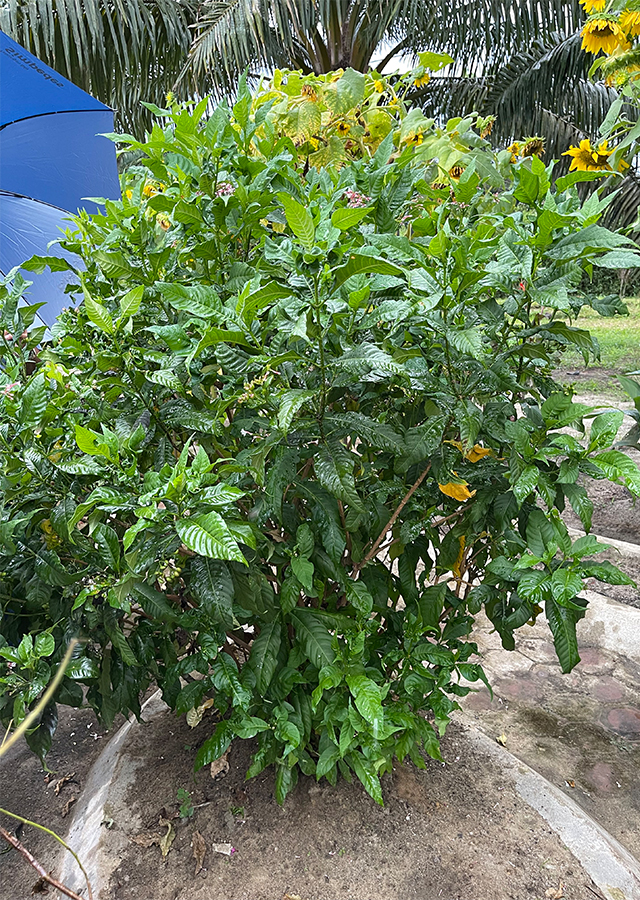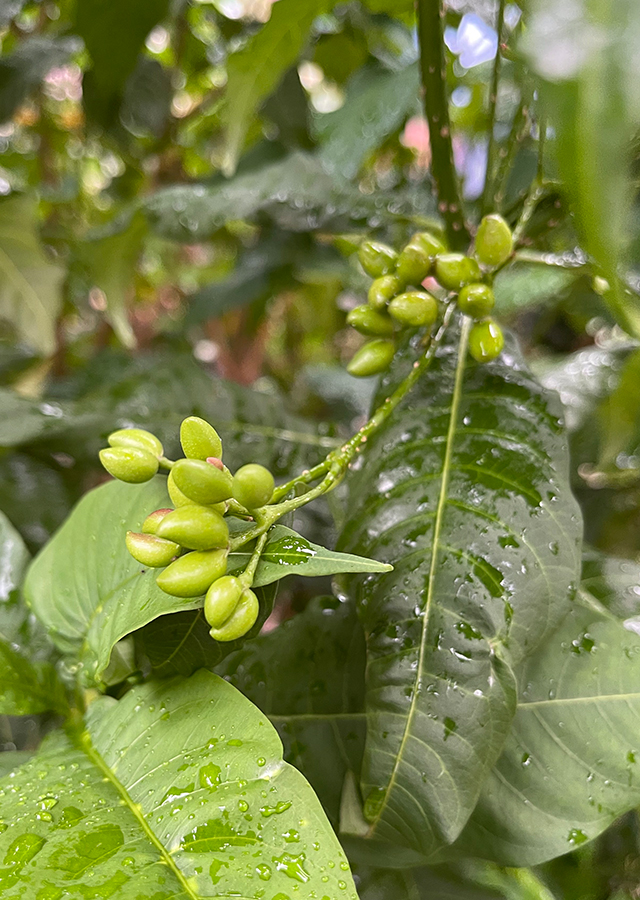Traditional Herbs from Rauvolfia serpentina
influenza
- Take 25 g of fresh pule pandak leaves, wash them thoroughly.
- Boil them in 3 glasses of water until 1 glass of water remains.
- Let it cool then strain.
- Drink.
pain_headed
- Prepare 10-15 g of pule pandak roots, wash until clean.
- Boil in 3 glasses of water until 1 glass of water remains.
- Let it cool then strain.
- Drink 2 times in the morning and evening, respectively each \u00bd glass
What is Rauvolfia serpentina Looks like??



Parts of Rauvolfia serpentina that could be used
- Leaves
- Bark
- Roots
Rauvolfia serpentina Distribution
Pule pandak is a species from the Apocynaceae family whose native distribution includes Bangladesh, Bhutan, China, Indonesia, India, Malaysia, Myanmar, Nepal, Pakistan, Sri Lanka, Thailand, Vietnam, Lao PDR. In Indonesia, there are many in the areas of Sumatra, Bali, Nusa Tenggara, especially concentrated on the island of Java. Pule pandak is an important medicinal plant in the Indian sub-continent and Southeast Asian countries. And has been used in traditional Indian medicine for more than 2,000 years. In 1949, more than 90% of Indian doctors used this plant in the treatment of hypertension. Likewise, in Ayurveda and Unani medicine, this species is also widely used to lower blood pressure (hypertension) and as an antidote to stings and bites from poisonous insects and reptiles. Pule pandak is also a source of compounds used in the pharmaceutical industry. In its use, people with chronic diseases of the digestive tract and women who are pregnant or planning a pregnancy in the near future are not advised to use this plant. Apart from being a medicinal plant, this species is also often planted by people in their home gardens as an ornamental plant.Agroecology of Rauvolfia serpentina
Pule pandak is often found growing wild in fields, teak forests or mountains. This species is a tropical plant and can grow well from the lowlands to an altitude of 1,000 m above sea level. This species is tolerant of various agroclimates, ranging from wet areas such as West Java to extreme dry areas such as East Nusa Tenggara. It grows best in areas where the annual daytime temperature is in the range of 22 - 30 °C, but can tolerate 4 - 35 °C, and the average annual rainfall is in the range of 1,500 - 3,500 mm, but tolerates 1,100 - 4,500 mmm. This species likes full sun and shade. Suitable for fertile, well-drained clay soil, with soil acidity (pH) in the range of 5.5 - 7, but can tolerate 5 - 7.5.
Morphology of Rauvolfia serpentina
- The roots are tuberous with a pale brown cork. The root shape is circular when planted in a pot, whereas when planted in an open area the root shape is straight like a rat's tail. The surface of the root is rough. Every time the root branches, fine roots (hair roots) grow.
- The stems are usually unbranched, cylindrical, slender, the branches are grayish brown and the young stems are green, gummy.
- The leaves are large, single (unifoliate), short-stemmed, the leaves are located opposite each other (opposite), lanceolate-elliptical, leaves about 3 - 20 cm long and 2 - 9 cm wide, three-circled, bright green and smooth, while the lower surface of the leaves is pale green and smooth pointed (acuminate) and the base of the leaves pointed (cuneate), the veins are pinnate.
- Compound flowers, have green flower stalks. The petals have lanceolate-shaped lobes purplish, slender, tube length between 1 - 1.5 cm. The crown is 5 in number, white, the lobes are elliptical-oval. The inflorescence is an umbrella that emerges from the tip of the stalk. The number of flowers per stalk reaches 25 - 35 flowers.\u00a0 Flowers bloom gradually, starting on the flower at the very edge.
- The fruit is a type of stone fruit, egg-shaped, with seeds, small, shiny, fleshy, young green fruit that turns into blackish purple when ripe. The number of fruit per stalk reaches 10 - 20.
- There are one seed in each fruit, small in size.
Cultivation of Rauvolfia serpentina
"Generative (seed) and vegetative propagation (grafting, root cuttings, tissue culture)." 1 year after planting. Ideally, pandan pule roots are harvested between 3 - 5 years of age, so that the optimum alkaloid content is obtained.
Rauvolfia serpentina, more details :
Chemical Content of Rauvolfia serpentinaIndole alkaloids (ajmalidine, ajmaline, ajmalinine, ajmalicine, aricine, canescine, coryanthine, deserpidine, isoajmaline, isoserine, isoserpiline, lankanescine, neoajmaline, papaverine, raubasine, raucaffricine, rauhimbine, rauwolfinine, recanescine, rescinnamine, reserpiline, reserpine, reserpinine, sarpagine, serpentine, serpentinine, thebaine, yohimbine, and yohimbinine), flavonoids, glycosides, cardiac glycosides, phlobatin, resins, saponins, steroids, tannins, triterpenoids, phenols, phytosterols, oleoresins.
Benefits of Rauvolfia serpentina
Treats hypertension, prevents stings and bites from poisonous insects and reptiles, mental disorders (calms), schizophrenia, impotence, eliminates cloudiness in the cornea, reduces heat or fever, treats pain in the intestines, stimulates uterine contractions, overcomes insomnia, treats headaches , sore throat, lumbago, toothache, stomach ache, influenza, epilepsy, acute hepatitis, malaria, diarrhea, hernia, cholera, colic, adenoids (hyperteroid), boils, scabies, wounds, bruises, and itching.
Simplisia of Rauvolfia serpentina
- Prepare the pandak pule roots,\u00a0wash them thoroughly with running water\u00a0then drain.
- Dry in direct sunlight for several days or in an oven at a temperature\u00a040 \u00b0C until the moisture content\u00a010%.
- Save\u00a0 u00a0simplisia in plastic or a clean, airtight container.
Another Facts for Rauvolfia serpentina :
Synonym of Rauvolfia serpentinaOphioxylon album Gaertn., Ophioxylon serpentinum L., Rauvolfia trifoliata (Gaertn.) Baill.
Habitus of Rauvolfia serpentina
Bush. Erect, annual shrub, growing up to 1 m tall from the rootstock
Habitat of Rauvolfia serpentina
- Forest
- Land
No comments:
Post a Comment